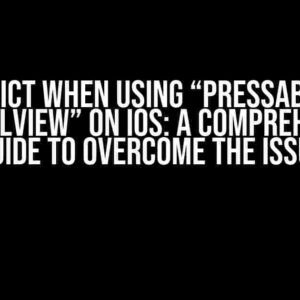Are you tired of dealing with transcription resets in your SwiftUI app every time you set the locale to US? You’re not alone! Many developers have struggled with this frustrating issue, but don’t worry, we’ve got you covered. In this comprehensive guide, we’ll dive into the reasons behind this problem and provide you with step-by-step instructions to resolve it once and for all.
What Causes SwiftUI App Transcription Resets?
Before we dive into the solution, it’s essential to understand the root cause of the issue. When you set the locale to US, SwiftUI’s underlying formatting and parsing mechanisms kick in, which can sometimes reset the transcription. This is because the formatting and parsing rules for different locales can conflict with each other, leading to transcription resets.
Locale-Specific Formatting and Parsing
In SwiftUI, the locale setting affects how dates, times, and numbers are formatted and parsed. For example, in the US locale, dates are typically formatted as MM/DD/YYYY, whereas in other locales, they might be formatted as DD/MM/YYYY. This difference in formatting rules can cause transcription resets when switching between locales.
SwiftUI’s Internal Mechanisms
SwiftUI’s internal mechanisms, such as its layout engine and binding system, can also contribute to transcription resets. When the locale is changed, SwiftUI’s internal state might get reset, causing the transcription to revert to its default state.
How to Resolve SwiftUI App Transcription Resets
Now that we’ve explored the causes, let’s get to the solutions! Here are the step-by-step instructions to resolve SwiftUI app transcription resets when setting the locale to US:
Step 1: Use a Custom Formatter
Create a custom formatter to handle date and time formatting in your app. This will ensure that the formatting rules remain consistent across all locales.
import SwiftUI
struct CustomDateFormatter: Formatter {
static let sharedInstance = CustomDateFormatter()
let DateFormatter: DateFormatter = {
let formatter = DateFormatter()
formatter.dateFormat = "yyyy-MM-dd HH:mm:ss"
return formatter
}()
}
extension Date {
func formatted() -> String {
return CustomDateFormatter.sharedInstance.DateFormatter.string(from: self)
}
}
Step 2: Use a Binding to Preserve Transcription State
Create a binding to preserve the transcription state when the locale is changed. This will ensure that the transcription remains intact, even when the locale is set to US.
import SwiftUI
struct TranscriptionBinding {
@Binding var transcriptionText: String
init(transcriptionText: Binding<String>) {
self._transcriptionText = transcriptionText
}
}
Step 3: Use a View Model to Manage Locale Changes
Create a view model to manage locale changes and ensure that the transcription state is preserved. This will provide a centralized approach to handling locale changes and transcription resets.
import SwiftUI
class LocaleManager {
@Published var locale: Locale = .current
@Published var transcriptionText: String = ""
func setLocale(to locale: Locale) {
self.locale = locale
// Preserve transcription state here
}
}
Step 4: Integrate with Your SwiftUI View
Integrate the custom formatter, binding, and view model with your SwiftUI view to ensure that the transcription resets are resolved.
import SwiftUI
struct TranscriptionView: View {
@StateObject var localeManager = LocaleManager()
@State var transcriptionText: String = ""
var body: some View {
VStack {
Text("Transcription Text:")
.font(.headline)
TextField("Enter transcription text", text: $transcriptionText)
.textFieldStyle(RoundedBorderTextFieldStyle())
.padding()
Button("Set Locale to US") {
localeManager.setLocale(to: .init(identifier: "en_US"))
}
.padding()
}
.onChange(of: localeManager.locale) { newValue in
// Update transcription state here
}
}
}
Conclusion
SwiftUI app transcription resets when setting the locale to US can be a frustrating issue, but by following the steps outlined in this guide, you can resolve it once and for all. Remember to use a custom formatter to handle date and time formatting, a binding to preserve transcription state, a view model to manage locale changes, and integrate everything with your SwiftUI view. With these solutions, you’ll be able to provide a seamless user experience for your app users, regardless of the locale setting.
Additional Tips and Best Practices
- Always test your app with different locales to ensure that the transcription resets are resolved.
- Use a consistent formatting and parsing approach throughout your app to avoid conflicts.
- Consider using a third-party library to handle date and time formatting, such as
swift-date. - Keep your app’s internal state in sync with the user’s locale setting to provide a seamless user experience.
| Locale | Date Format | Time Format |
|---|---|---|
| US | MM/DD/YYYY | HH:mm:ss |
| UK | DD/MM/YYYY | HH:mm:ss |
| France | DD/MM/YYYY | HH:mm:ss |
By following these best practices and solutions, you’ll be able to create a robust and user-friendly SwiftUI app that handles transcription resets with ease. Happy coding!
FAQs
Q: Why do I need to use a custom formatter?
A: A custom formatter ensures that the formatting rules remain consistent across all locales, avoiding transcription resets.
Q: How do I preserve the transcription state when the locale is changed?
A: Use a binding to preserve the transcription state, and integrate it with your view model to manage locale changes.
Q: Can I use a third-party library to handle date and time formatting?
A: Yes, consider using a third-party library like swift-date to handle date and time formatting in your app.
Q: How do I ensure that my app’s internal state is in sync with the user’s locale setting?
A: Use a view model to manage locale changes and ensure that the app’s internal state is updated accordingly.
Here are 5 Questions and Answers about “SwiftUI App Transcription Resets When Locale Set To US”:
Frequently Asked Question
Are you experiencing issues with your SwiftUI app’s transcription resetting when the locale is set to US? Worry not, we’ve got you covered!
Why does my SwiftUI app’s transcription reset when I set the locale to US?
This issue occurs because SwiftUI uses the locale to determine the formatting of dates, times, and numbers. When you set the locale to US, SwiftUI resets the transcription to its default state, causing any customized transcriptions to be lost.
How can I prevent my SwiftUI app’s transcription from resetting when I set the locale to US?
One solution is to use the `@State` property wrapper to store the transcription data in a separate state variable. This way, the transcription data will not be affected by changes to the locale.
Is this issue specific to SwiftUI apps or can it occur in other types of apps as well?
This issue is specific to SwiftUI apps that use the `Locale` API to format dates, times, and numbers. Other types of apps may not experience this issue, as they may use different APIs or frameworks to handle locale changes.
Can I use a third-party library to fix this issue?
Yes, there are third-party libraries available that provide workarounds for this issue. For example, you can use a library like `SwiftFormat` to preserve the transcription data when the locale changes. However, it’s recommended to explore native SwiftUI solutions before relying on third-party libraries.
Will Apple fix this issue in future versions of SwiftUI?
While Apple has not officially acknowledged this issue, the SwiftUI community has reported it as a bug. It’s possible that Apple may address this issue in future versions of SwiftUI, but until then, developers will need to implement workarounds to preserve transcription data when the locale changes.



